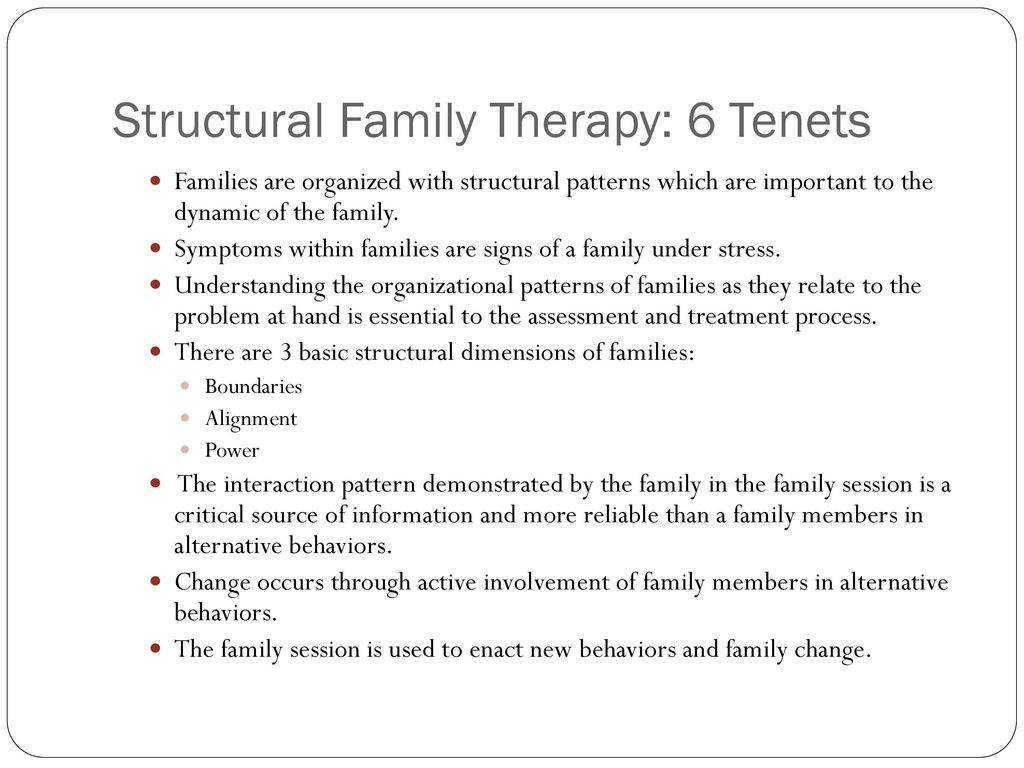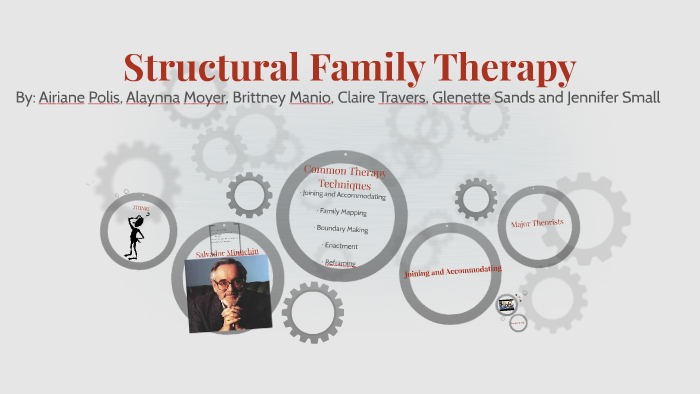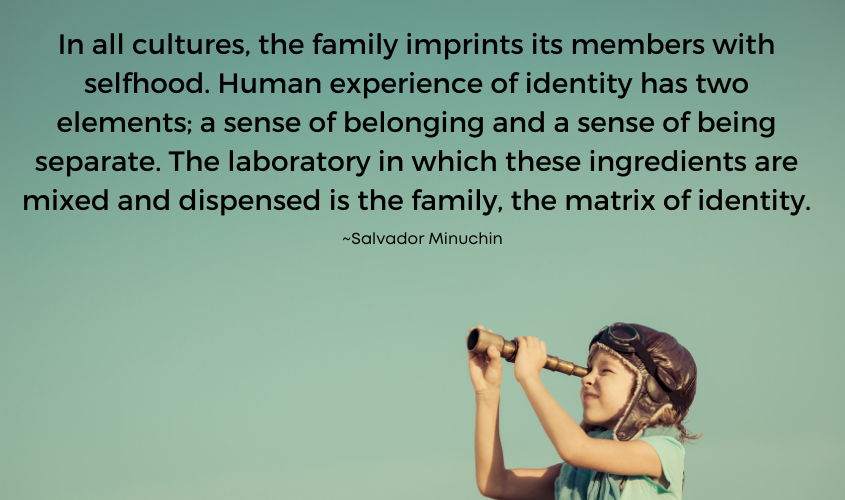Structural family therapy is a form of psychotherapy that was developed by Salvador Minuchin in the 1960s. It is a systemic approach to treatment that focuses on the relationships and interactions within a family, rather than the individual psychological issues of its members. Structural family therapy is based on the belief that the family is a system with its own structure and patterns of communication, and that problems within the family can be resolved by changing the structure and patterns of interaction.
One key concept of structural family therapy is the idea of boundaries. Boundaries refer to the ways in which family members relate to each other and to the outside world. In a healthy family, boundaries are clear and well-defined, allowing each member to have their own autonomy and independence while still being connected to the rest of the family. In a dysfunctional family, however, boundaries may be blurred or rigid, leading to conflicts and misunderstandings. Structural family therapists work with families to identify and clarify boundaries, helping them to develop healthier patterns of communication and interaction.
Another important concept in structural family therapy is the idea of hierarchy. In a family, there is usually a power dynamic at play, with certain members holding more power or influence than others. This can be due to a variety of factors, such as age, gender, or role within the family. Structural family therapists help families to identify and understand these power dynamics, and to find ways to balance the power among family members. This can involve role negotiation and role clarification, as well as helping family members to develop more effective communication skills.
A third key concept in structural family therapy is the idea of subsystems. Within a family, there may be various subgroups or subsystems that function separately from the rest of the family. For example, a couple may have their own subsystem within the larger family system, or a parent and child may have a subsystem of their own. Structural family therapists help families to identify and understand these subsystems, and to find ways to integrate them more effectively into the overall family system. This can involve helping families to develop healthier communication patterns and to better understand the needs and concerns of each subsystem.
Overall, structural family therapy is a valuable approach to treatment that focuses on the relationships and interactions within a family. By helping families to identify and understand key concepts such as boundaries, hierarchy, and subsystems, structural family therapists can help families to develop healthier patterns of communication and to resolve conflicts and problems within the family system.
Key concepts of structural family therapy

Within this organization, the structural therapist uses seven steps that could be considered interventions or techniques. Finally, in the seventh step the therapist challenges unproductive assumptions that support structural problems Nichols, 2010. Consequently, it called for psychologists to develop alternative approaches for the counseling. Wright Marriage, Couple, and Family Therapy HUMN — 6356 — 3 Dr. Therefore, a therapist may reinforce a parent who supports their child to follow a specific rule.
Conceptual Models

In this regard, it is evident that the problem is considered as a part of the family structure rather than an issue of the individual. But many times, enmeshment can lead to struggles with identity, decisiveness, and assertiveness. It is important for structural family therapists to be constantly aware and sensitive to different diversity, cultural, and gender issues that may relate to clients when doing therapy. Rigid family systems rarely support individual thought. Int J Environ Res Public Health. The Seven Principles For Making Marriage Work: A practical guide from the international bestselling relationship expert— John Gottman This is an excellent read for any non-professionals who wish to learn more about what family therapy can do for couples.
Structural Family Therapy: Definition, Types, Uses & Techniques

Group Therapy: Three Points And Goals Of Family Therapy 1561 Words 7 Pages According to Horne 2002 intervention and planning therapy are closely connected. Family Therapy: Concepts and Methods— Michael Nichols and Sean Davis Those with only a casual interest in family therapy may not find much of interest in this book, but anyone who wishes to gain a deeper understanding of the theory and practice of family therapy will find this book invaluable. Tries to find out how current problems could be caused due to this influence. Routledge; New York, NY, USA: 2011. Minuchin started developing the method by seeking to change transform families into therapeutic entities. Similarities, Differences and New Lessons Learnt While considering psychoanalytical approach, it was noted that the two methods focus on the rules and relationships of the family in the light of interacting with each other. Structural Family Therapy SFT is a form of In structural family therapy, there is a goal established to help improve communication and the way family members interact with each in order to then create healthy communication, appropriate boundaries, and eventually healthier family structure.
Structural Family Therapy Quiz Flashcards

Essential Skills in Family Therapy: From the First Interview to Termination— JoEllen Patterson, Lee Williams, Todd M. In these households, members are expected to follow certain beliefs without question. Davis This is another helpful resource for new therapists. He traveled to the United States and trained in child psychiatry Nichols, 2010. Sprenkle This book is a fantastic resource for those with little or no experience in family therapy. This homework is intended to change the way family members interact by assessing and adjusting the way the family communicates and makes decisions. The ability to adapt and change when in recovery mode sustain in way of empowering …show more content… Especially, when family members need help adjusting to a new set of individuals or familiar attitudes, goals, and behaviors.
What Is Family Therapy? + 6 Techniques & Interventions

Image Courtesy of Wikimedia. According to Minuchin 2012 , the family structural theory emphasis on the important of the family structure and its changes that occurs and how the individuals in the family relate collectively over time to put up and accept each other. The exercises and techniques below are meant to be used within the context of a therapeutic working relationship, but some also have applications for those who wish to explore the possibilities of family therapy before committing to long-term treatment with a therapist. This can help people see experiences more positively. It also allows the family members to become more in tune with one another and can be applied with siblings, a parent, a child, or even couples in marriage counseling. Profiles in caregiving: The unexpected career. Implications of perceived neighborhood quality, daily discrimination, and depression for social integration across mid- and later life: A case of person-environment fit? It requires the family members to give each other their full attention, cooperate with one another, and communicate with both words and body language.







